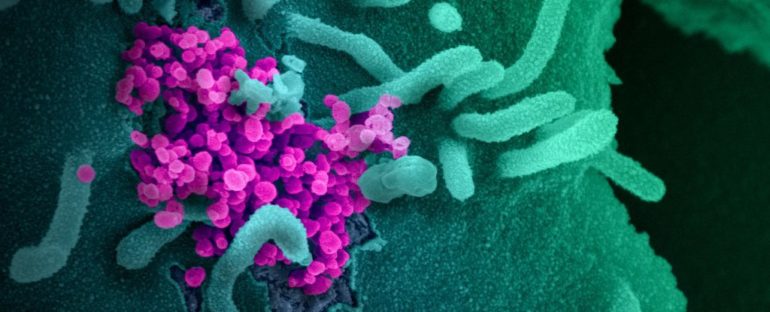As the world passes the harrowing milestone of 4 million COVID-19 deaths, and new virus variants wreak chaos in unvaccinated communities, debate continues to rage over the question whether SARS-CoV-2 leaked from a research facility.
Now a group of scientists – including world-leading virologists and a Nobel Laureate – have risen to the challenge with a critical review of the scientific evidence to date, concluding there is currently no proof the virus that causes COVID-19 sprung from a lab.
“Our careful and critical analysis of the currently available data provided no evidence for the idea that SARS-CoV-2 originated in a laboratory,” says virologist and lead author Edward Holmes, who before this pandemic, worked on the viruses which caused Ebola outbreaks and influenza epidemics.
Knowing a lab breach cannot be ruled out completely, the group summarizes the evidence for the natural origins of SARS-CoV-2 and argues that human activities, such as deforestation and wildlife trade, “have repeatedly put us on a collision course with novel viruses.”
They also warn that the focus on a highly improbable lab origin is distracting from more urgent scientific tasks, such as investigating animal sources of SARS-CoV-2, or preparing for the next pandemic – like we should have done for this one.
“The current preprint provides a refreshingly clear and reasoned description of the virological events that have taken place during the emergence of the pandemic virus,” says virologist Jonathan Stoye from the Francis Crick Institute, who was not involved in the review.
Evidence in favor of the animal origins of SARS-CoV-2 is found in closely related viruses detected in bats and pangolins, and via people interacting with those animals.
The review, which is available as a preprint and undergoing peer-review, also cites other evidence which is inconsistent with the lab leak theory: SARS-CoV-2 is unable to infect lab mice, a go-to animal model of choice for studying viral infections.
And if someone artificially engineered the virus in a lab, there would be genetic markers of that process in the SARS-CoV-2 sequence – which cannot be found.
“[The review] makes a strong case for the natural origin of the virus followed by on-going adaptation in humans,” Stoye says.
While several early documented cases of COVID-19 were linked to the now-closed Wuhan wet market, in the end it “was more of an amplifying event rather than necessarily a true ground zero. So we need to look elsewhere for the viral origins,” public health researcher Dominic Dwyer, who was part of the WHO investigation in Wuhan, wrote back in February.
However, as the new review outlines, there is still no epidemiological evidence connecting SARS-CoV-2 – or possible precursors – to the Wuhan Institute of Virology, where researchers do study bat-borne coronaviruses.
“The key source would be an infected worker that may have taken it home after being infected in the lab,” says Stuart Turville, a virologist at the Kirby Institute in Sydney, Australia. “Yet this is not documented in any early index cases.”
As comprehensive as the latest review is, the ‘lab leak’ scenario can’t be ruled out conclusively, which leaves room for doubts to creep in. Even the WHO investigation was not conclusive.
“No single research trip can provide all the answers,” WHO Director-General Tedros Adhanom Ghebreyesus said in March this year, when the WHO released its first report detailing its extensive investigation into the origins of SARS-CoV-2.
By and large, experts currently agree that the most probable scenario is that the virus was circulating in wild animals, spilled over into human contacts, and then naturally evolved to adapt to its newest host.
However, immunologist Nikolai Petrovsky from Flinders University in Australia is less certain, saying the new analysis provides “minimal hard evidence” and no solid conclusions.
“The actual origins of the virus remains a completely open verdict split between a natural spillover event from a still unidentified animal vector, or a laboratory accident,” says Petrovsky.
“Based on actual knowledge to date, neither possibility can be either proven or definitely refuted.”
Other experts are more supportive of the review and its findings. Infectious disease epidemiologist James Wood at the University of Cambridge says:
“They considered the uncertainties that invariably persist around retrospective investigations of this nature and also noted that a laboratory accident could not be entirely ruled out, but that this was highly unlikely relative to an origin involving human and animal contact.”
The historical record of other so-called zoonotic viruses which have jumped from animals into humans, is further evidence supporting the animal origins of SARS-CoV-2, the group argues.
“All previous human coronaviruses have zoonotic origins, as have the vast majority of human viruses,” they write before acknowledging that the exact animal source of the coronavirus may never be found, which probably gave wind to the lab leak theory in the first place.
“Indeed, the animal origins of many well-known human pathogens, including Ebola virus, Hepatitis C virus, poliovirus, and [other] coronaviruses … are yet to be identified,” the group writes.
A few things are more certain, though: Conspiracy theories and rumors are downright dangerous, even deadly, and we must learn from this pandemic, to protect ourselves for the next.
The review is available on the preprint server Zenodo.



